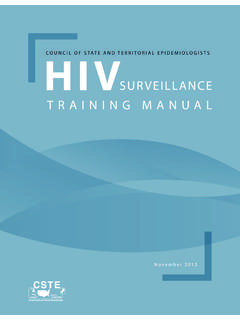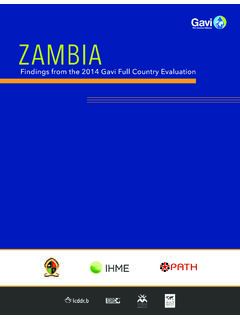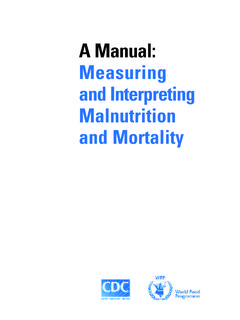Transcription of A Guide to the Implementation of the t National …
1 T A Guide to the Implementation of the National electronic disease surveillance system ( nedss ) in State Public Health Agencies C S T E. Council of State and Territorial Epidemiologists Edited by: Gianfranco Pezzino, MD, MPH. t A Guide to the Implementation of the National electronic disease surveillance system ( nedss ) in State Public Health Agencies C S T E. Council of State and Territorial Epidemiologists Edited by: Gianfranco Pezzino, MD, MPH. State Epidemiologist, Kansas Department of Health and Environment Table of Contents Executive Acknowledgments ..iii I ~ Objectives ..1. Target II ~ nedss and the nedss Background ..1. The concept of integrated system : the integration continuum.
2 2. The multiple layers of modern information The nedss architecture and its elements ..4. III ~ nedss Implementation options for state programs ..7. Fully integrated system ..7. Separate system sharing common tools ( data warehouse )..9. CDC-developed nedss software ..14. State-developed How many systems should be targeted for inclusion in nedss ?..15. How to choose the best model ..16. IV ~ Fitting nedss into a state plan: resources and other nedss requires state The cost of NOT implementing Connectivity and security issues ..18. electronic data Legal and ethical FAQs ..23. Glossary of Terms and list of Acronyms ..25. i Executive Summary This document is targeted to program managers and surveillance staff in state health agencies who are involved in the Implementation of the National electronic disease surveillance system ( nedss ).
3 The target audience includes epidemiologists and other professional staff with varying degrees of computer knowledge and skills. The goals of the document are: A ~ To present the basic principles of the nedss architecture and how they affect state-based surveillance systems;. B ~ To assist state surveillance programs in deciding how to implement the nedss architecture;. C ~ To discuss some current issues related to the nedss Implementation . The document is divided into three sections. Section I describes nedss and the nedss architecture. Included in that section is a discussion of what an integrated system is and how the integration of multiple systems can be achieved in different ways.
4 The multiple layers of modern information systems ( , user interface, middle layer with business rules, and database) are also discussed. Finally, the nedss architecture and its elements are summa- rized. Section II deals more in detail with nedss Implementation options for state programs. Fully integrated systems are compared with data warehouses. The option of using CDC-developed nedss software is discussed against the alternative of adopting state-developed applications. Some guidance is provided on how to choose the best solution for each state and how many systems should be included in nedss . Section III includes a brief description of the resources needed at the state level for the Implementation of nedss .
5 In addition, connectivity, security, and other important issues (such as confidentiality and legal authority to collect and access surveillance information) are discussed. A section with Frequently Asked Questions (FAQs) and a glossary complete the document. nedss is an important initiative, originated in part as a result of requests and proposals formulated by state epi- demiologists and their professional organization, the Council of State and Territorial Epidemiologists (CSTE). It has the potential to change dramatically the way public health surveillance is conducted in this country. We hope that this document, while not exhaustive or comprehensive, can be helpful in assisting those of us who struggle every day to remain an active part of this process.
6 Ii Acknowledgments Many individuals provided crucial contributions to this document. Within CSTE, Donna Knutson, Shah Roohi, and Jonathan Stevens were actively involved in the compilation of the document. In addition, the members of CSTE's Executive Committee provided important feedback to finalize the draft (Jerry Gibson, SC; Dr. Henry Anderson, WI; Richard Hopkins, FL; John Middaugh, AK; Jesse Greenblatt, NH; Mathew Cartter, CT; Suzanne Jenkins, VA; Robert Rolfs, UT; and Steven Macdonald, WA). Many staff members from CDC also provided important input to this document including Claire Broome, Denise Koo, Joseph Reid, Scott Danos, Dan Jernigan, and others. Garland Land, MO; Gayle Hansen, KS; Perry Smith and Mike Davisson, NY; and Don Ward, FL; provided the information included in the side text boxes on lessons learned.
7 Rhoda Nicholas, UT; contributed to the section on the concept of data warehouse. While the document is the result of a team effort, the ultimate responsibility for any errors or inaccuracies is only mine. Please direct your comments to me at the following address: Gianfranco Pezzino, MD, MPH. State Epidemiologist Kansas Department of Health and Environment 900 SW Jackson, Suite 1051. Topeka, KS 66612. Phone (785) 296-6536. Fax (785) 291-3775. April 2, 2001. iii I ~ Objectives 1) Target audience This document was prepared by CSTE members and staff, with substantial input from CDC staff from the National electronic disease surveillance system project. The primary target audience includes program managers and surveillance staff in state health agencies who are involved with collecting, pro- cessing, and analyzing information in electronic format and who need to learn more about the nedss .
8 Concepts and Implementation process. The target audience includes primarily epidemiologists and other professional staff with various degrees of computer knowledge and skills. Staff with more technical func- tions ( , computer specialists and programmers) may find the document helpful to understand the purpose of nedss , but this is not meant to be a comprehensive technical guidance document. 2) Goals A ~ To outline the basic principles of the nedss architecture and how they affect state-based surveillance systems;. B ~ To assist state surveillance programs in deciding how to implement the nedss architecture;. C ~ To discuss some current issues related to the nedss Implementation .
9 II ~ nedss and the nedss architecture 1) Background The current collaboration between the Centers for disease Control and Prevention (CDC) and its public health partners includes the Implementation and management of over one hundred surveillance and health information systems. These systems may be part of suggested activities for partners in exchange for funding to deliver vital public health services at the state and local levels. Each center, institute and office at CDC has surveillance needs that are met by the collection of data at the state and local level. Many of these systems have been in place for several years, and were originally commissioned to detect simple disease and disability conditions.
10 All these systems are administered independently and use non-standardized formats for variable definition and grouping. In addition, these systems are, in general, unable to communicate with one another. One consequence of this situation is the inability to build a true National disease surveillance sys- tem. In the absence of such a system , the identification of bioterrorist events or outbreaks with poten- tially National impact is very problematic. In addition, the presence of multiple, non-integrated systems leads to an undesirable error rate in the records, an inefficient use of time and labor, a potential for under- or over-reporting, and a duplication of efforts.











